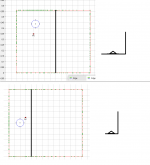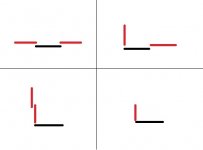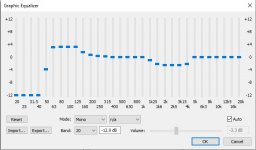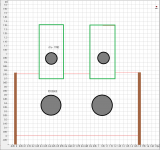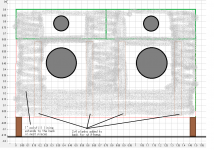There is a lack of OB FR discussions, and of those that exist it is usually about how it will not work well or about some of the rare FR drivers that are actually suited to it.
I still did some testing with the a7p FR in an OB early on and misleading test results along with confirmation bias from what I had read made me believe it does indeed not work well.
The most misleading test was using a huge (something like 2x1.5m) but very flimsy baffle to test how much baffle size might be able improve perceived bass response with a single FR driver. This huge baffle sounded very bright still, and didn't seem much better than than a smaller (15x22'') MDF baffle.
This was mostly due to baffle resonances adding lots of extra and unpleasant HF energy.
The reality is that baffle size is very important, even a few inches goes a long way, but it is not as simple as a change in sensitivity.
For the purpose of testing you could set a low volume to avoid excessive distortion with EQ but no matter how you EQ the bass/mids you will not be get the same warmth and body that a few extra inches of baffle width brings it seems.
The biggest mistake (and in hindsight the most obvious) was trying to avoid EQ for the sake of 'purity' and assuming that forcing bass response out of small FR driver could never sound good.
Complex digital EQ was basically the key to getting good balanced sound out of them.
A very sharp filter for most of the subsonics reduced a lot of induced distortion in mids, highs, even upper bass.
A small boost in upper bass, where sensitivity is still fairly high, helped make up for the missing bass.
Still being on leaner side, some EQ to tame the a7p upper mid peakiness went a long way.
The result was a very enjoyable punchy sounding speaker, being a headphone user probably makes it easier to appreciate though.
It doesn't have anywhere near the same room-filling scale as the 2-way OB WAW config, you are very much listening to 2 speakers, but this small FR is able to cover so much on it's own that it just doesn't really feel worth it to deal with the complications and downsides to the 2 way.
I'm pretty curious what other arrangements could do, say an a12p or an a12pw (the low extension and HF roll-off could work well here), maybe even a 2nd A7p in series/parallel.
It would be surprising if this a7p arrangement was a decent example of an OB FR... but maybe it is a well balanced example? bass quality is very good, it is merely lacking a bit of body and obviously extension, not sure the tradeoffs in HF quality with a larger FR would even be worth it.
Would like to hear any experiences with similar builds or approaches.
I still did some testing with the a7p FR in an OB early on and misleading test results along with confirmation bias from what I had read made me believe it does indeed not work well.
The most misleading test was using a huge (something like 2x1.5m) but very flimsy baffle to test how much baffle size might be able improve perceived bass response with a single FR driver. This huge baffle sounded very bright still, and didn't seem much better than than a smaller (15x22'') MDF baffle.
This was mostly due to baffle resonances adding lots of extra and unpleasant HF energy.
The reality is that baffle size is very important, even a few inches goes a long way, but it is not as simple as a change in sensitivity.
For the purpose of testing you could set a low volume to avoid excessive distortion with EQ but no matter how you EQ the bass/mids you will not be get the same warmth and body that a few extra inches of baffle width brings it seems.
The biggest mistake (and in hindsight the most obvious) was trying to avoid EQ for the sake of 'purity' and assuming that forcing bass response out of small FR driver could never sound good.
Complex digital EQ was basically the key to getting good balanced sound out of them.
A very sharp filter for most of the subsonics reduced a lot of induced distortion in mids, highs, even upper bass.
A small boost in upper bass, where sensitivity is still fairly high, helped make up for the missing bass.
Still being on leaner side, some EQ to tame the a7p upper mid peakiness went a long way.
The result was a very enjoyable punchy sounding speaker, being a headphone user probably makes it easier to appreciate though.
It doesn't have anywhere near the same room-filling scale as the 2-way OB WAW config, you are very much listening to 2 speakers, but this small FR is able to cover so much on it's own that it just doesn't really feel worth it to deal with the complications and downsides to the 2 way.
I'm pretty curious what other arrangements could do, say an a12p or an a12pw (the low extension and HF roll-off could work well here), maybe even a 2nd A7p in series/parallel.
It would be surprising if this a7p arrangement was a decent example of an OB FR... but maybe it is a well balanced example? bass quality is very good, it is merely lacking a bit of body and obviously extension, not sure the tradeoffs in HF quality with a larger FR would even be worth it.
Would like to hear any experiences with similar builds or approaches.
Last edited:
this is what I did with 2 pair of Philips 12" fullrangers:
Philips AD12100/M8 in open baffle
Philips AD12100/M8 in open baffle
I don´t have much experience with OB but am using an Alpair 7.3 on a slim 36cm baffle in a 2-way.I still did some testing with the a7p FR in an OB early on and misleading test results along with confirmation bias from what I had read made me believe it does indeed not work well.
You could (theoretically) EQ the driver a little towards lower frequencies but will get heavy penalties with regards to max. SPL (which would be very very low) and sound quality in the mid/treble-range. And still the bass response won´t be satisfying.
Software like "the edge", "basta" or vituix cad should give you an idea what you can expect on whatever sized baffle.
I´d dare say that a 2-way is the absolute least you would need.
Especially so because the Alpair is such a very nice driver but you won´t get the best of it alone on an OB.
I´m using a Peerless 830669 on a slim baffle but there are many to choose from.
I cross at ~350Hz with 12dB/oct. at the moment.
https://www.diyaudio.com/forums/attachments/multi-way/923139d1613490761-fast-fun-inexpensive-ob-project-offene-schallwand_1080333-jpg
Trying to get the most out of a full range OB is an interesting challenge. As you've discovered a large baffle has it's own downsides, not least of which, to my mind, is it's use of edge diffractions to smooth out the on axis response. You will lose one of the main advantages of a full range driver, that is, it being a point source.
An L-frame might be better in that regard since it has a smaller forward facing baffle area, but I think a torus has a lot of potential. Whilst it hasn't been built to my knowledge there are some very good simulations of a torus in this thread Did Siegfried Linkwitz miss a trick?
Also a thread here Torus
An L-frame might be better in that regard since it has a smaller forward facing baffle area, but I think a torus has a lot of potential. Whilst it hasn't been built to my knowledge there are some very good simulations of a torus in this thread Did Siegfried Linkwitz miss a trick?
Also a thread here Torus
The base baffle is a shallow u-frame, but that is more about the reinforcement provided by the wings than baffle size. From a recent test there are boards attached to the backs of the wings to increase baffle width , sort of an _n_ shape.
Some extra width without cavity resonance would be good, I think with L-frame optimal placement on the front of the baffle would shift towards one side, closer to the fold.
'Optimal' placement for bass extension based on Edge sims,
driver placement is not as easy to experiment with so have just went of what edge says.
Some extra width without cavity resonance would be good, I think with L-frame optimal placement on the front of the baffle would shift towards one side, closer to the fold.
'Optimal' placement for bass extension based on Edge sims,
driver placement is not as easy to experiment with so have just went of what edge says.
If you're looking for something with similar low end performance to a boxed speaker, I'd agree a 2-way is the bare minimum.
The baffle is 22'' high and with added side boards it is about 26'' wide, now that you mention it some effects of widening baffle were certainly starting to appear at this width.
I will try making it one of the sideboards perpendicular the front of the baffle to make into an L frame, if that's better I will try wider boards to see how deep L-frame can go.
Thanks for the suggestion
The baffle is 22'' high and with added side boards it is about 26'' wide, now that you mention it some effects of widening baffle were certainly starting to appear at this width.
I will try making it one of the sideboards perpendicular the front of the baffle to make into an L frame, if that's better I will try wider boards to see how deep L-frame can go.
Thanks for the suggestion
Testing different frames gave some interesting and useful results.
L frame seems to be the way to go, but maybe has it's limits.
The driver position changes in different configs and therefore so does baffle response in different configs, the exact effects are not super clear.
A wider front baffle like 1st example really does degrade imaging quality and additionally (or as a side effect of the imaging) it sounds less detailed..
Only thing that sounded worse was a u-frame, it gave most bass though.
2nd example was marginal improvement but making baffle narrower was more benefitial.
3rd example with most extreme L-frame was ok, better than rest, it just sounded a bit off and it is difficult to say what exactly was the cause...
Reflections off the side? maybe with some damping material it would improve.
Decreased distance from back wall? not sure if the deepest part of L-frame counts as the 'back' , didn't bother testing it further way cos my space is already too limited to accommodate that.
Some mild type of cavity resonance starting to form? I thought it had some slight similarities in sound to the u-frame.
Compared to the final example, the shallow L-frame, there was not much improvement to bass response anyway.
Shallow L-frame had the best set of compromises and it what I will use now, Edge response appears to be a bit more balanced compared others, maybe that is related.
Top of the 2nd image shows driver placement, there is actually a woofer below on it the baffle right now.
On bottom: The front baffle can be made much narrower with a very similar response and with edges near either side of the driver vs nearer a corner , however it would mean an extreme L-frame... I would like to try it.
Testing was done in mono, you can the notice with the L-frames the image becomes slightly asymmetrical, for the shallow one I would say it is a benign effect and in stereo there would be no asymmetry .
Could be related to any of factors mentioned for the deeper L-frame.
Still need to check if L-frame is better on the inside or outside of the speaker pair.
L frame seems to be the way to go, but maybe has it's limits.
The driver position changes in different configs and therefore so does baffle response in different configs, the exact effects are not super clear.
A wider front baffle like 1st example really does degrade imaging quality and additionally (or as a side effect of the imaging) it sounds less detailed..
Only thing that sounded worse was a u-frame, it gave most bass though.
2nd example was marginal improvement but making baffle narrower was more benefitial.
3rd example with most extreme L-frame was ok, better than rest, it just sounded a bit off and it is difficult to say what exactly was the cause...
Reflections off the side? maybe with some damping material it would improve.
Decreased distance from back wall? not sure if the deepest part of L-frame counts as the 'back' , didn't bother testing it further way cos my space is already too limited to accommodate that.
Some mild type of cavity resonance starting to form? I thought it had some slight similarities in sound to the u-frame.
Compared to the final example, the shallow L-frame, there was not much improvement to bass response anyway.
Shallow L-frame had the best set of compromises and it what I will use now, Edge response appears to be a bit more balanced compared others, maybe that is related.
Top of the 2nd image shows driver placement, there is actually a woofer below on it the baffle right now.
On bottom: The front baffle can be made much narrower with a very similar response and with edges near either side of the driver vs nearer a corner , however it would mean an extreme L-frame... I would like to try it.
Testing was done in mono, you can the notice with the L-frames the image becomes slightly asymmetrical, for the shallow one I would say it is a benign effect and in stereo there would be no asymmetry .
Could be related to any of factors mentioned for the deeper L-frame.
Still need to check if L-frame is better on the inside or outside of the speaker pair.
Attachments
Last edited:
The L-frame should definitely be on outside of the 2 speakers, sounds very 'boxed in' with them on inside, which is not surprising I suppose.
After some listening time they sound remarkably good, even warmer than the larger baffles , I think this is because first null after dipole peak is small.
Correct placement is seeming like it's more important than absolute size for perceived warmth/body.
This was the EQ profile:
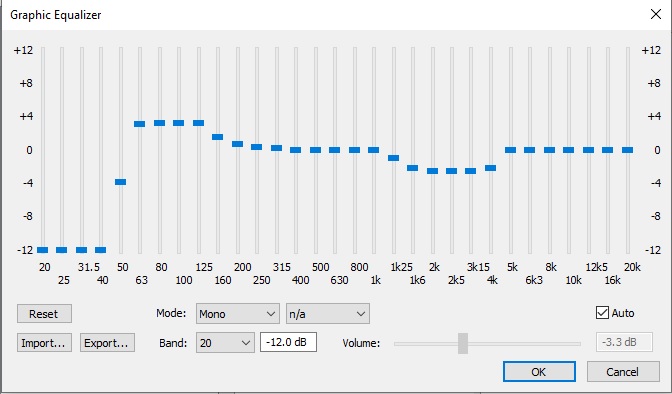
The dip in the upper mids is no longer needed or wanted.
After this experience I'm very much interested in moving to a larger FR.
A12p is the obvious choice but I would prefer to try a metal cone, as it turns out the A11MS is nearly ideal.
Higher Xmax and Vd than the 12p with a smaller cone.
Very nice response curve, a bump in the optimal bass area and rise at the upper end makes passive EQ more feasible, still probably not worth it, the sharp subbass cutoff has huge benefits.
The thin frame is nice too, no need to recess the driver makes baffle design easier and more flexible.
Low Qts of the larger MA drivers is favourable, a big and virtually inaudible peak around 40Hz would not be good.
After some listening time they sound remarkably good, even warmer than the larger baffles , I think this is because first null after dipole peak is small.
Correct placement is seeming like it's more important than absolute size for perceived warmth/body.
This was the EQ profile:
The dip in the upper mids is no longer needed or wanted.
After this experience I'm very much interested in moving to a larger FR.
A12p is the obvious choice but I would prefer to try a metal cone, as it turns out the A11MS is nearly ideal.
Higher Xmax and Vd than the 12p with a smaller cone.
Very nice response curve, a bump in the optimal bass area and rise at the upper end makes passive EQ more feasible, still probably not worth it, the sharp subbass cutoff has huge benefits.
The thin frame is nice too, no need to recess the driver makes baffle design easier and more flexible.
Low Qts of the larger MA drivers is favourable, a big and virtually inaudible peak around 40Hz would not be good.
Attachments
Last edited:
The L-frame should definitely be on outside of the 2 speakers, sounds very 'boxed in' with them on inside, which is not surprising I suppose.
Interesting results, thanks for posting. Regards the above, I wonder if you are hearing some panel resonance, the wing is not well braced or damped.
A good compromise to get larger baffle area in smaller space for an OB multiway is having the drivers share one large baffle.
Below is just a rough test setup, it was quick and reversible to just attach the 11MS open baffles to this wooden headboard that I had mounted the 2 P830668 on for an earlier test. There is excessive distance between the woofer and FR, the Edge response looks pretty bumpy for all the drivers.
Despite this and all other potential issues of sharing a single flat baffle for all drivers it sounds pretty great already.
The 11MS manages to maintain low IMD in midrange with heavy bass so it is ideal for OB WAW, this was my issue using the alpair 7p in a similar OB application, I wanted to cross it higher to lower IMD but the P830668 cone break up would become too audible.
On this baffle the 11MS is 1st order high passed at 100Hz with -0.8dB attenuation (sensitivity is quite well matched to P830668). the 11MS sounded good running even left running fullrange, it was a bit cleaner and coherent sounding this way and I wanted to have some protection for over-excursion.
The P830668 sound best low passed at 750Hz, surprisingly high, I think after getting some use at real volumes (enough to create some cone movement) the mid range smoothed out and of course the vastly increased low bass efficiency helps.
The OB woofers are amazing for the simple reason that you basically only hear them and not the room, bass emanates from the baffle only, attack and decay is very fast for more realistic impact, more definition, and it persists up to very high volumes.
The is in a 9x11' concrete wall listening room.
Below is just a rough test setup, it was quick and reversible to just attach the 11MS open baffles to this wooden headboard that I had mounted the 2 P830668 on for an earlier test. There is excessive distance between the woofer and FR, the Edge response looks pretty bumpy for all the drivers.
Despite this and all other potential issues of sharing a single flat baffle for all drivers it sounds pretty great already.
The 11MS manages to maintain low IMD in midrange with heavy bass so it is ideal for OB WAW, this was my issue using the alpair 7p in a similar OB application, I wanted to cross it higher to lower IMD but the P830668 cone break up would become too audible.
On this baffle the 11MS is 1st order high passed at 100Hz with -0.8dB attenuation (sensitivity is quite well matched to P830668). the 11MS sounded good running even left running fullrange, it was a bit cleaner and coherent sounding this way and I wanted to have some protection for over-excursion.
The P830668 sound best low passed at 750Hz, surprisingly high, I think after getting some use at real volumes (enough to create some cone movement) the mid range smoothed out and of course the vastly increased low bass efficiency helps.
The OB woofers are amazing for the simple reason that you basically only hear them and not the room, bass emanates from the baffle only, attack and decay is very fast for more realistic impact, more definition, and it persists up to very high volumes.
The is in a 9x11' concrete wall listening room.
Attachments
Last edited:
Hi,
1st order passive HP will not result in any protection for the poor small widerange driver, in contrary. At main resonance, SPL will come back, sometimes even more as without any filter at all.
The only way to use a pssive 1st order HP in a WAW is having a parallel LCR to the wideband which flattens the impedance at resonance and allows the C to work correctly. 100Hz HP and 750Hz LP sounds strange, especially in an OB. Have you measured or calculated?
All the best
Mattes
1st order passive HP will not result in any protection for the poor small widerange driver, in contrary. At main resonance, SPL will come back, sometimes even more as without any filter at all.
The only way to use a pssive 1st order HP in a WAW is having a parallel LCR to the wideband which flattens the impedance at resonance and allows the C to work correctly. 100Hz HP and 750Hz LP sounds strange, especially in an OB. Have you measured or calculated?
All the best
Mattes
True but only for passive XO, I should have mentioned this is using PLLXO .
They were strange XO points and I think it was to do with the extremely erratic response of the baffle and driver placement
This was a crude first test for seeing the potential of using a single baffle for all the drivers.
A lot of adjustments have been made since and still a WIP.
Below is another rough diagram of current state of it and overall it is a big improvement over last example.
I will need to find out the new optimal XO again using software but
already obvious is that the 11ms no longer needs any attenuation and the woofer lowpass point is going to be lower.
One thing for sure with polyfill lining it is a strong contestant for ugliest speaker ever built.
I can of course get most extended response yet from 11ms alone on this baffle and the lining addressed some of my previous SQ issues of using large baffles, but it will be hard to go back to not having the strong OB bass response of the woofers.
They were strange XO points and I think it was to do with the extremely erratic response of the baffle and driver placement
This was a crude first test for seeing the potential of using a single baffle for all the drivers.
A lot of adjustments have been made since and still a WIP.
Below is another rough diagram of current state of it and overall it is a big improvement over last example.
I will need to find out the new optimal XO again using software but
already obvious is that the 11ms no longer needs any attenuation and the woofer lowpass point is going to be lower.
One thing for sure with polyfill lining it is a strong contestant for ugliest speaker ever built.
I can of course get most extended response yet from 11ms alone on this baffle and the lining addressed some of my previous SQ issues of using large baffles, but it will be hard to go back to not having the strong OB bass response of the woofers.
Attachments
Last edited:
- Home
- Loudspeakers
- Full Range
- Single FR OB experiences
